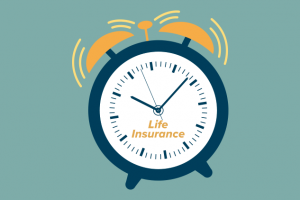Life insurance is less expensive—and more necessary—than you may realize.
Our brains are not well-equipped to picture just how much our circumstances are going to change over time. As a result, we tend to underestimate risk and take our current lifestyle for granted. Change, however, is inevitable, and the sooner we plan for the future, the better it will be when it finally arrives. Life insurance is an important part of this plan—it gives us the peace of mind in knowing that our loved ones will be secure after we’re gone.
Sadly, almost half of us are living without it. According to Life Happens, only 57% of Americans in 2019 own life, meaning four out of every ten households would struggle to pay living expenses at the loss of a family member.
Most of this is due to a lack of awareness. When quizzed, Life Happens found that only 46% of people knew enough about life insurance to pass. People also largely overestimated the annual cost of a policy; most people guessed around three times more than the average annual.
This lack of knowledge is understandable—life insurance is not exactly enthusiastically discussed at every dinner table in America. That’s why Life Insurance Awareness Month was established: to help you get the information you need about life insurance that you rarely meet in your daily life.
What is life insurance?
 Life insurance comes in many shapes and sizes, from term policies meant to get you through your highest-earning income years to whole life policies that last throughout your lifetime.
Life insurance comes in many shapes and sizes, from term policies meant to get you through your highest-earning income years to whole life policies that last throughout your lifetime.
With a life insurance policy, your family will be insured with what is called a death benefit, a lump sum that is paid upon your passing to help them get through the expenses of the coming years.
In addition to the death benefit, certain policies come with extra features such as the ability to accumulate cash value over time or living benefits to cover medical costs while you’re still alive.
The type of policy needed varies per person, but this outline will help you know what to look for.
Do I need life insurance?
 It’s never too late to get a handle on your financial future, and it’s never too early to get yourself covered. The best time to start is always now. No matter where you are in life, there’s a policy that will meet your needs.
It’s never too late to get a handle on your financial future, and it’s never too early to get yourself covered. The best time to start is always now. No matter where you are in life, there’s a policy that will meet your needs.
If you have a family, your insurance needs are direct: you want to make sure they have money after you’re gone. Your life insurance will cover their immediate, ongoing, and future expenses.
If you’re single, you won’t need life insurance right away, but that doesn’t mean you should wait. You’re currently at peak insurability, which means you’ll have the lowest rates. If you start saving now, you’ll already have coverage for when you do start a family.
When should I get life insurance?
 If you aren’t covered already, here are some life events and stages where you’ll want to consider getting life insurance:
If you aren’t covered already, here are some life events and stages where you’ll want to consider getting life insurance:
- Marriage: Owning a policy will protect your spouse from having to pay the mortgage alone or scrambling to pay for the funeral during the grieving process.
- Parenthood: If you already have an established family, you’re protecting your children’s futures and their college savings. Life insurance can also shield your spouse from having to double their work as a caregiver.
- Buying a house: Life insurance can help your family pay down or retire your mortgage after you’re gone.
- Retirement: You’ll want a policy to protect your spouse’s retirement savings, and to ease their financial burden in their remaining years.
What policy is right for me?
 The right choice depends on what you value most in your policy.
The right choice depends on what you value most in your policy.
Looking for the lowest possible rates? Term insurance is for you. It covers you for a finite amount of time from one to thirty years, with twenty being the most common. After this time has ended, the policy will lapse, and you will no longer be covered.
Want longer coverage? Try permanent insurance. This is a long-term form of coverage that doesn’t expire as long as you pay premiums on it. These policies can accumulate cash value over time and can offer features like living benefits.
Other types of permanent insurance include whole life, universal life, variable life, and variable universal life. Do you want predictability? Whole life is for you, where all your premiums are a fixed amount. If you want the flexibility of adjustable premiums, ask for universal life.
Finally, if you’re looking for greater returns on your investment and are willing to incur a little risk, a variable plan is for you. These are offered via prospectus and are built from an investment portfolio, giving you the opportunity to earn more over time.
Of course, this is only a broad overview of your options. For a more in-depth analysis of your needs, an insurance agent will better help you evaluate your situation.
It’s easier than you think.
 When you know what your options are, getting life insurance coverage is actually quite simple. Once you face the difficult facts of death, you’ll be able to put it out of your mind and live safely knowing your family has protection after you’re gone.
When you know what your options are, getting life insurance coverage is actually quite simple. Once you face the difficult facts of death, you’ll be able to put it out of your mind and live safely knowing your family has protection after you’re gone.
Like a trip to the doctor or dentist, the unpleasantness of planning is brief compared to the benefit of a healthy financial life. Don’t get caught unprepared; get life insurance for the ones you love.
To find out how much insurance you need, read our earlier post, “Do You Have Enough Life Insurance?” and go to Life Happens’ interactive life insurance calculator.




